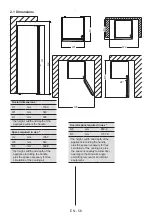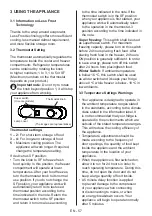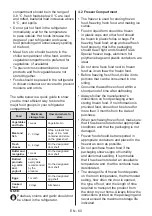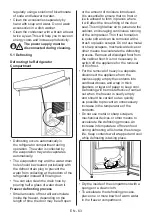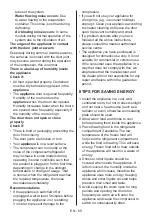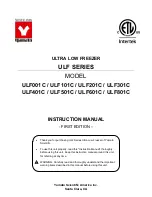
EN - 64
• Examine the contents when replacing
them in the freezer and if some of the
packages have thawed out, they should
be eaten within 24hours, or be cooked
and re-frozen.
•
After defrosting is complete, clean the
inside of the appliance with a solution
of warm water and a little bicarbonate
of soda, then dry thoroughly. Wash all
removable parts in the same way and
reassemble. Reconnect the appliance
to the mains supply and leave for 2 to
3 hours on setting number MAX before
introducing the food back into the freezer.
Replacing LED Lighting
To replace any of the LEDs, please contact
the nearest Authorised Service Centre.
Note:
The numbers and location of the
LED strips may change according to
the model.
6 SHIPMENT AND
REPOSITIONING
6.1 Transportation and Changing
Positioning
•
The original packaging and foam may be
kept for re-transportation (optional).
• Fasten your appliance with thick
packaging, bands or strong cords and
follow the instructions for transportation
on the packaging.
• Remove all movable parts or fix them
into the appliance against shocks
using bands when re-positioning or
transporting.
Always carry your appliance in the
upright position.
6.2 Repositioning the Door
•
It is not possible to change the opening
direction of your appliance door if door
handles are installed on the front surface
of the appliance door.
•
It is possible to change the opening
direction of the door on models with
handle on the side of the door or without
handles.
•
If the door-opening direction of your
appliance can be changed, contact the
nearest Authorised Service Centre to
change the opening direction.
7 BEFORE CALLING AFTER-
SALES SERVICE
If you are experiencing a problem with
your
appliance
, please check the following
before contacting the after-sales service.
Your appliance is not operating
Check if:
• There is power
•
The plug is correctly placed in the socket
•
The plug fuse or the mains fuse has
blown
•
The socket is defective. To check this,
plug another working appliance into the
same socket.
The appliance performs poorly
Check if:
•
The appliance is overloaded
•
The appliance door is closed properly
•
There is any dust on the condenser
•
There is enough space near the rear and
side walls.
Your appliance is operating noisily
Normal noises
Cracking noise occurs:
•
During automatic defrosting
•
When the appliance is cooled
or warmed (due to expansion of
appliance material).
Short cracking noise occurs:
When
the thermostat switches the compressor
on/off.
Motor noise:
Indicates the compressor
is operating normally. The compressor
may cause more noise for a short time
when it is first activated.
Bubbling noise and splash occurs:
Due to the flow of the refrigerant in the







